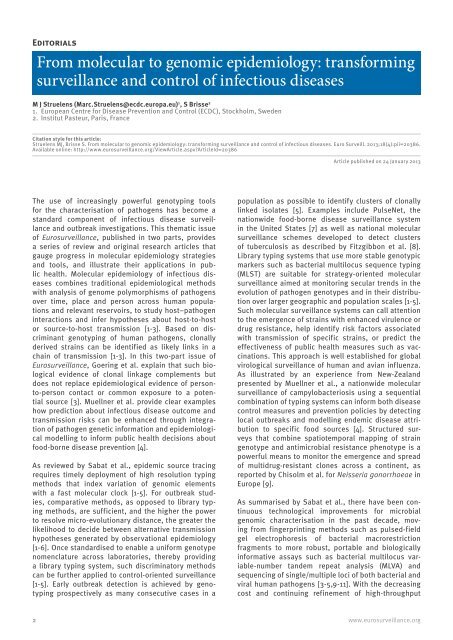Neisseria meningitidis - Eurosurveillance
Neisseria meningitidis - Eurosurveillance
Neisseria meningitidis - Eurosurveillance
You also want an ePaper? Increase the reach of your titles
YUMPU automatically turns print PDFs into web optimized ePapers that Google loves.
Editorials<br />
From molecular to genomic epidemiology: transforming<br />
surveillance and control of infectious diseases<br />
M J Struelens (Marc.Struelens@ecdc.europa.eu) 1 , S Brisse 2<br />
1. European Centre for Disease Prevention and Control (ECDC), Stockholm, Sweden<br />
2. Institut Pasteur, Paris, France<br />
Citation style for this article:<br />
Struelens MJ, Brisse S. From molecular to genomic epidemiology: transforming surveillance and control of infectious diseases. Euro Surveill. 2013;18(4):pii=20386.<br />
Available online: http://www.eurosurveillance.org/ViewArticle.aspx?ArticleId=20386<br />
The use of increasingly powerful genotyping tools<br />
for the characterisation of pathogens has become a<br />
standard component of infectious disease surveillance<br />
and outbreak investigations. This thematic issue<br />
of <strong>Eurosurveillance</strong>, published in two parts, provides<br />
a series of review and original research articles that<br />
gauge progress in molecular epidemiology strategies<br />
and tools, and illustrate their applications in public<br />
health. Molecular epidemiology of infectious diseases<br />
combines traditional epidemiological methods<br />
with analysis of genome polymorphisms of pathogens<br />
over time, place and person across human populations<br />
and relevant reservoirs, to study host–pathogen<br />
interactions and infer hypotheses about host-to-host<br />
or source-to-host transmission [1-3]. Based on discriminant<br />
genotyping of human pathogens, clonally<br />
derived strains can be identified as likely links in a<br />
chain of transmission [1-3]. In this two-part issue of<br />
<strong>Eurosurveillance</strong>, Goering et al. explain that such biological<br />
evidence of clonal linkage complements but<br />
does not replace epidemiological evidence of personto-person<br />
contact or common exposure to a potential<br />
source [3]. Muellner et al. provide clear examples<br />
how prediction about infectious disease outcome and<br />
transmission risks can be enhanced through integration<br />
of pathogen genetic information and epidemiological<br />
modelling to inform public health decisions about<br />
food-borne disease prevention [4].<br />
As reviewed by Sabat et al., epidemic source tracing<br />
requires timely deployment of high resolution typing<br />
methods that index variation of genomic elements<br />
with a fast molecular clock [1-5]. For outbreak studies,<br />
comparative methods, as opposed to library typing<br />
methods, are sufficient, and the higher the power<br />
to resolve micro-evolutionary distance, the greater the<br />
likelihood to decide between alternative transmission<br />
hypotheses generated by observational epidemiology<br />
[1-6]. Once standardised to enable a uniform genotype<br />
nomenclature across laboratories, thereby providing<br />
a library typing system, such discriminatory methods<br />
can be further applied to control-oriented surveillance<br />
[1-5]. Early outbreak detection is achieved by genotyping<br />
prospectively as many consecutive cases in a<br />
Article published on 24 January 2013<br />
population as possible to identify clusters of clonally<br />
linked isolates [5]. Examples include PulseNet, the<br />
nationwide food-borne disease surveillance system<br />
in the United States [7] as well as national molecular<br />
surveillance schemes developed to detect clusters<br />
of tuberculosis as described by Fitzgibbon et al. [8].<br />
Library typing systems that use more stable genotypic<br />
markers such as bacterial multilocus sequence typing<br />
(MLST) are suitable for strategy-oriented molecular<br />
surveillance aimed at monitoring secular trends in the<br />
evolution of pathogen genotypes and in their distribution<br />
over larger geographic and population scales [1-5].<br />
Such molecular surveillance systems can call attention<br />
to the emergence of strains with enhanced virulence or<br />
drug resistance, help identify risk factors associated<br />
with transmission of specific strains, or predict the<br />
effectiveness of public health measures such as vaccinations.<br />
This approach is well established for global<br />
virological surveillance of human and avian influenza.<br />
As illustrated by an experience from New-Zealand<br />
presented by Muellner et al., a nationwide molecular<br />
surveillance of campylobacteriosis using a sequential<br />
combination of typing systems can inform both disease<br />
control measures and prevention policies by detecting<br />
local outbreaks and modelling endemic disease attribution<br />
to specific food sources [4]. Structured surveys<br />
that combine spatiotemporal mapping of strain<br />
genotype and antimicrobial resistance phenotype is a<br />
powerful means to monitor the emergence and spread<br />
of multidrug-resistant clones across a continent, as<br />
reported by Chisolm et al. for <strong>Neisseria</strong> gonorrhoeae in<br />
Europe [9].<br />
As summarised by Sabat et al., there have been continuous<br />
technological improvements for microbial<br />
genomic characterisation in the past decade, moving<br />
from fingerprinting methods such as pulsed-field<br />
gel electrophoresis of bacterial macrorestriction<br />
fragments to more robust, portable and biologically<br />
informative assays such as bacterial multilocus variable-number<br />
tandem repeat analysis (MLVA) and<br />
sequencing of single/multiple loci of both bacterial and<br />
viral human pathogens [3-5,9-11]. With the decreasing<br />
cost and continuing refinement of high-throughput<br />
2 www.eurosurveillance.org
















